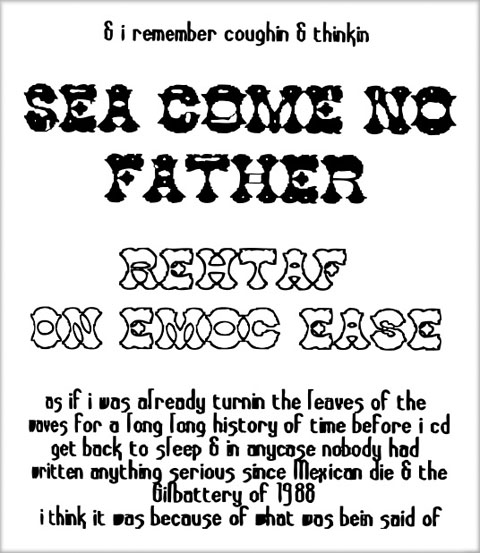Notes on videolectics
By Nicholas Laughlin
DS (2), by Kamau Brathwaite
(New Directions, ISBN 978-0-8112-1693-7, 272 pp)
Page from DS (2)
The phase of his life that Kamau Brathwaite has called his “Time of Salt” began with three traumatic events. In 1986, his wife Doris was unexpectedly diagnosed with cancer, and died just three months later, a period recorded in The Zea Mexican Diary (1993). In 1988, Hurricane Gilbert ravaged Jamaica and destroyed his house in Irish Town; he lost an unparalleled archive of his own and others’ work that had taken over thirty years to assemble. Finally, in 1990, three gunmen broke into his apartment in Kingston; one of them put a gun to the poet’s head and pulled the trigger. The chamber was empty, but Brathwaite believes a psychic bullet “killed” him at that moment. He was reborn in some sense, and since then his poetics have correspondingly changed.
What they changed into, of course, is his groundbreaking (and often bewildering) “Sycorax video style,” which he describes as “a use of computer fontage to visualise his sense of dream & morph & riddim drama — videolectic enactment.” It emerged fully in Dreamstories (1994): a visual poetry, using the resources of an early computer word processor, deploying a variety of typefaces and styles, unconventional syntax and punctuation, and sometimes idiosyncratic spellings. “Sycorax video style” cannot properly be quoted; it must be visually reproduced. As his name for it makes clear, Brathwaite sees this form as a rebellion against “Prospero’s” poetry, staid lines advancing in orderly fashion from left to right, and stanzas marching in ranks down the page.
Apart from producing new “Sycoraxian” works, Brathwaite has also revised older poems to suit his current aesthetic. Ancestors (2001) “revise(d) & xtended” his trilogy Mother Poem (1977), Sun Poem (1982), and X/Self (1987) — turning up the volume, as it were, on the older work, and emphasising the bass and percussion. His latest book, DS (2) (i.e. Dreamstories part two), does the same for nine shorter poems, previously published (in Prosperonian incarnations, no doubt) in journals and anthologies.
Some readers see the “videolectic” as a means of scoring the poems for voice, the sizes and shapes of the words suggesting directions for performance. For others, it is a subversion of the canons of English poetry, representing a particularly Caribbean way of dealing with words. Or else it is an attempt to update printed text for the multimedia age, by making it more “interactive.” At the very least, “video style” forces you to pay closer attention to the words.
But it can also, frankly, make the poems difficult to read (sometimes even physically difficult, with abruptly shrinking type straining the eyes, or ornate fonts breaking up into near-abstract shapes). Any writer with a highly distinctive literary style runs the risk of slipping into affectation, and the perhaps worse risk of mistaking style for substance. Unfortunately that happens exasperatingly often in DS (2). Some of these poems look more interesting than they read.
Because these are dream stories, their narrative flow often follows the illogical, elliptical, inconclusive pattern of real dreams. “The Professor”, the first piece in the book, recounts a meeting (real or imagined?) with F.R. Leavis from Brathwaite’s student days at Cambridge in the 1950s. “Meridiam” is a stream-of-consciousness record of a sleepless night spent listening to the radio. “DreamHaiti” tells the imagined story of a group of Haitian refugees intercepted by the US Coast Guard. Of course, to describe these poems in such flat sentences is like calling “The Schooner Flight” a poem about a mulatto sailor: accurate, but misleading. Poetry, almost by definition, defies paraphrase, and poems as complexly composed as Brathwaite’s require reading aloud, preferably in a Bajan accent, before they begin to reveal their secrets. But even when those secrets do appear, tangled with private references, the reader — this reader — will be forgiven, I hope, for wondering if his patience has been rewarded.
Coming to the end of DS (2), as the type went through its final dramatic fluctuations in size, I wondered if after fifteen years of exploring his “Sycorax video style” Brathwaite might not be ready to take what seems the obvious next step. Where once it seemed cutting-edge, with its 1980s low-tech bitmap aesthetic, this “videolectic enactment” today looks slightly quaint. A decade ago, the world went online; a truly interactive style is now not just hyperlinked, but multimedia. Imagine a Brathwaite poem that actually spoke or sang as you made your way through it, words changing colour and shape before your eyes, each image giving way at a click to dozens more: Prospero’s order permanently undone in the tempest of virtual space. Hundreds of writers are already creating works like this. Maybe it’s time for someone to introduce Brathwaite to the possibilities of the World Wide Web. If he does all this with just ink and paper, imagine what he’ll do with gigabytes and pixels.
•••
The Caribbean Review of Books, May 2007
Nicholas Laughlin is the editor of The Caribbean Review of Books.





